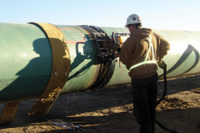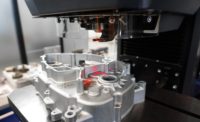The AS9100 standard remains one of the most well-known and successful models of an industry-operated-and-driven standard in existence today. AS9100 was released in 1999 by the Society of Automotive Engineers and the European Association of Aerospace Industries and is regularly attuned to marketplace needs. Currently in its third incarnation—Revision C, which was released in 2009—aviation, space and defense companies all have a vested interest in the standard, and many require compliance with AS9100 as a requisite for doing business.
To stay true to its function of responding to industry needs, AS9100 is undergoing another amendment: Revision D. According to the Americas Aerospace Quality Group (AAQG), the standard must remain compliant with ISO 9001 (the quality management system standard upon which it is based) which itself is due for an upgrade in September 2015. As it stands,
AS9100 Revision D should be finalized roughly in December 2015.
The beauty of these industry-wide standards is that they are, in many ways. Industry dictated and aerospace companies are encouraged to provide feedback to help shape the standards’ evolution. According to experts in the field, these changes could encompass changes in the language about requirements for control of monitoring and measuring equipment (they could be moved from product realization to measurement, analysis and improvement) and some say there is room for development in the standardization of risk management techniques.
Here to clarify what to expect from Revision D, as well as to explain how AS9100 has changed since its second revision, are Aaron Troschinetz, technical/operations manager of aerospace at SAI Global, Robert L. Keys, aerospace program/sector manager at DNV GL—Business Assurance, and Michael Harder, senior technical manager at LRQA:
NDT Magazine: What changes took place from AS9100 revision B to revision C?
Aaron Troschinetz:The main focus with revision changes from AS9100B to AS9100C included an expanded scope and set of requirements with risk management, project management, and configuration management, as well as critical items/special requirements. These specific change areas of the AS9100C standard insured a more comprehensive set of tools for organizations with managing risk specifically from supplier to customer-type of relationships. As of July 1st, 2012; all organizations were required to have made the changeover from AS9100B to AS9100C.
Robert Keys: [They include] added definitions to Clause Three; added risk management and project management to Clause Seven; some expanded (and deleted) requirements based on feedback from aero-space industry stakeholders, including OEMs, ABs, CBs, AABs, TPABs, registered organizations and aerospace auditors.
Michael Harder:The scope of the standard was revised and expanded. It was previously titled as an aerospace quality management standard. It now encompasses and is applicable to aviation, space and defense (both land-and sea-based systems). The standard defines “critical items” and “special require-ments”, providing guidance for how these items are to be assessed. It also now more comprehensively examines the concepts of program management, risk management and configuration management.
NDT: Do you have any knowledge you could share about AS9100 revision D? When is it expected to be finalized, and what changes will it encompass?
MH:The intent of the International Aerospace Quality Group (IAQG) is to have AS9100 Rev. D issued within three months of the official release of the next revision of ISO 9001. ISO9001:2015 is in draft review and is currently projected to be issued in September 2015. AS9100 Revision D should therefore be expected to be finalized approximately in December 2015.
RK:The IAQG has a team beginning meetings on the re-formatting of the current AS9100C document to the new formats. Revisions will be discussed, undertaken by the writing team and approved by IAQG prior to release.
AT:AS9100D is a work product associated with the Americas Aerospace Quality Group (AAQG)/ Americas Aerospace Quality Standards Committee (AAQSC) writing committee and as part of this overall activity, the AS9100D has been collecting various stakeholder and industry feedback for some time (post-AS9100C release). As with any of the AS-series standards, the writing committees maintain a very close relationship with each other (including AS9101, AS9104 as well as AS9110/AS9120) and regularly work toward a constant level of readiness with required changes.
NDT: Why is AS9100 effective? Why and how does it continue to be relevant?
AT:The AS9100 standard remains a very effective instrument for the overall global aerospace community in that it serves as the framework for organizations in realizing the ultimate goal to its affected customers – On-Time, On-Quality Delivery (OTQD). An organization subscribing to AS9100 has the tools it effectively requires to demonstrate this objective, as well as the framework behind it, which is harmonized globally. The aviation, space and defense industries rely on this framework through their receipts of delivered products and services from these organizations, and often [use them in] their own product realization processes, as well.
RK:The standard covers the registration of quality management systems and requirements for aviation, space and defense organizations. It is used worldwide to maintain Industry Controlled Other Party (ICOP) accredited management system certifications to the AS9100 standard in the OASIS (Online Supplier Information System) database by nationally-accredited certification bodies. Aerospace OEMs use the standard and registration to the standard as contractual requirements for their supplier base.
MH:The aerospace industry is highly dependent upon the effectiveness of its supply chain to provide well-designed, robust, high-quality products in a timely and predictable manner. The industry has always intended AS9100 to be an instrument for establishing uniformity of requirements and expectations in the performance and continual improvement of its supply chain. Utilizing the ISO9001 model for management of quality system requirements and the validation of compliance by third-party assessment, AS9100 was written to include additional requirements that are of particular interest to the aerospace industry. These include added requirements for project management, risk management, configuration management, process verification and control, and post-delivery support; as well as augmented requirements for contract review, design, procurement, product verification (inspection/test); and timely and effective response to non-conformances. Because the safety and performance aspects of aerospace products are critical to stakeholders, it is appropriate to have an uncompromising standard such as AS9100 for guidance.
NDT: Do you see room for improvement with AS9100? Anything you hope will be incorporated into revision D?
MH:There will always be room for improvement with any quality management system standard. This underlies the concept of continual improvement that was explicitly added in the 2000 version of ISO9001 and has been part of the standard and its derivatives ever since. As a registrar, we welcome any change that brings better defined and objectively reviewable criteria, such as specific requirements for procedural documentation and records. Also, it is anticipated that requirements for control of monitoring and measuring equipment (colloquially referred to as calibration) will be moved from product realization to measurement, analysis and improvement. We believe this is a good and appropriate change.
AT:As we move toward AS9100D, we’ve certainly seen drastic market improvement in the overall aviation, space and defense supply chain’s awareness and application of risk management techniques; however, there is possibly more room for improvement in some of the standardization of risk management techniques that could be realized. While risk management is certainly scalable, our industry demands a very high level of risk management with our processes that could benefit from further harmonization and definition.



